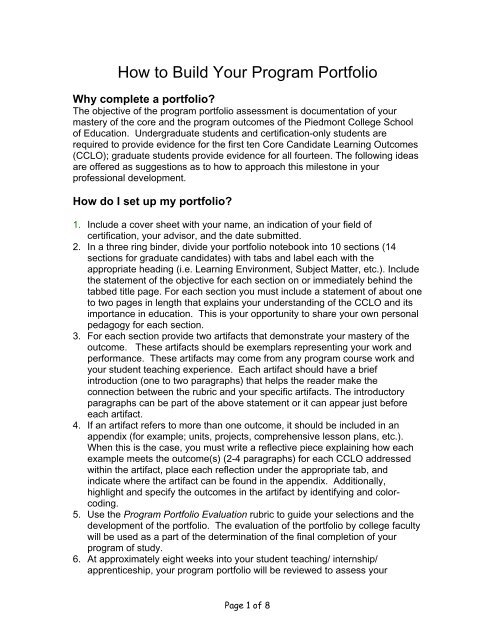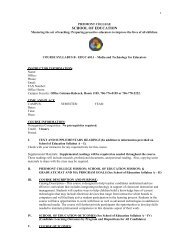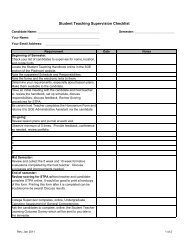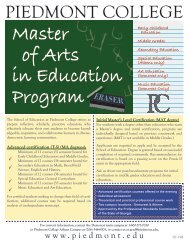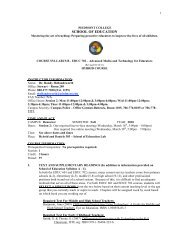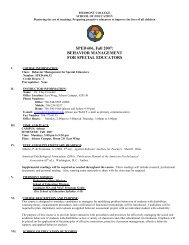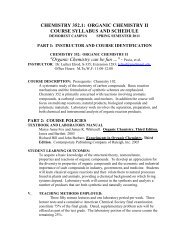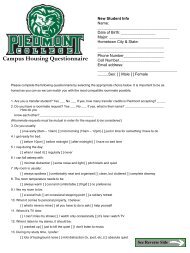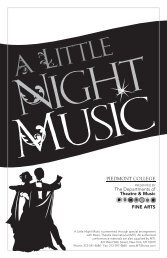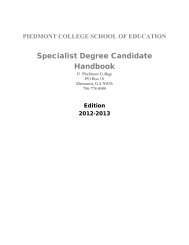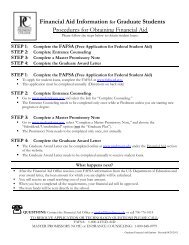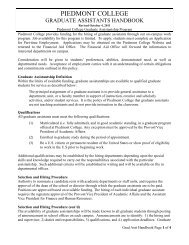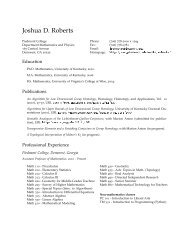How to Build Your Program Portfolio - Piedmont College
How to Build Your Program Portfolio - Piedmont College
How to Build Your Program Portfolio - Piedmont College
You also want an ePaper? Increase the reach of your titles
YUMPU automatically turns print PDFs into web optimized ePapers that Google loves.
<strong>How</strong> <strong>to</strong> <strong>Build</strong> <strong>Your</strong> <strong>Program</strong> <strong>Portfolio</strong>Why complete a portfolio?The objective of the program portfolio assessment is documentation of yourmastery of the core and the program outcomes of the <strong>Piedmont</strong> <strong>College</strong> Schoolof Education. Undergraduate students and certification-only students arerequired <strong>to</strong> provide evidence for the first ten Core Candidate Learning Outcomes(CCLO); graduate students provide evidence for all fourteen. The following ideasare offered as suggestions as <strong>to</strong> how <strong>to</strong> approach this miles<strong>to</strong>ne in yourprofessional development.<strong>How</strong> do I set up my portfolio?1. Include a cover sheet with your name, an indication of your field ofcertification, your advisor, and the date submitted.2. In a three ring binder, divide your portfolio notebook in<strong>to</strong> 10 sections (14sections for graduate candidates) with tabs and label each with theappropriate heading (i.e. Learning Environment, Subject Matter, etc.). Includethe statement of the objective for each section on or immediately behind thetabbed title page. For each section you must include a statement of about one<strong>to</strong> two pages in length that explains your understanding of the CCLO and itsimportance in education. This is your opportunity <strong>to</strong> share your own personalpedagogy for each section.3. For each section provide two artifacts that demonstrate your mastery of theoutcome. These artifacts should be exemplars representing your work andperformance. These artifacts may come from any program course work andyour student teaching experience. Each artifact should have a briefintroduction (one <strong>to</strong> two paragraphs) that helps the reader make theconnection between the rubric and your specific artifacts. The introduc<strong>to</strong>ryparagraphs can be part of the above statement or it can appear just beforeeach artifact.4. If an artifact refers <strong>to</strong> more than one outcome, it should be included in anappendix (for example; units, projects, comprehensive lesson plans, etc.).When this is the case, you must write a reflective piece explaining how eachexample meets the outcome(s) (2-4 paragraphs) for each CCLO addressedwithin the artifact, place each reflection under the appropriate tab, andindicate where the artifact can be found in the appendix. Additionally,highlight and specify the outcomes in the artifact by identifying and colorcoding.5. Use the <strong>Program</strong> <strong>Portfolio</strong> Evaluation rubric <strong>to</strong> guide your selections and thedevelopment of the portfolio. The evaluation of the portfolio by college facultywill be used as a part of the determination of the final completion of yourprogram of study.6. At approximately eight weeks in<strong>to</strong> your student teaching/ internship/apprenticeship, your program portfolio will be reviewed <strong>to</strong> assess yourPage 1 of 8
progress and provide feedback. The final portfolio is due no later than theend of the thirteenth week of your experience.<strong>Your</strong> portfolio will be evaluated on a 4-point scale. You are doing well in yourexperience if you receive a rating in the range of 2-3. Rarely would a candidatereceive a 4 as a beginning practitioner.What should I do when building my <strong>Portfolio</strong>?Start now! The official due date approximately coincides with your FullTime (solo) teaching. It will be an extremely stressful time. It will be evenmore stressful if you have this major project <strong>to</strong> complete at the same time.Read the <strong>Portfolio</strong> rubric carefully. Know what the CCLO states and whatis expected <strong>to</strong> demonstrate proficiency. Tell what you know, have learned,believe and/or value about the CCLO in your introduction.Select your artifacts carefully: <strong>How</strong> does the artifact demonstrate yourmastery of the CCLO?Include two artifacts for each section. There is no limit <strong>to</strong> the number ofpages in an artifact. Placing a title page divider in front of each artifactclarifies which pages you intend <strong>to</strong> serve as the artifact. (A classroomdiagram, pictures, and description count as one artifact. A lesson plan withworksheets and assessments counts as one artifact.)Double check your introduction and artifacts against the rubric.Reread everything in your portfolio <strong>to</strong> check for typing/spelling mistakes,proper grammar, and punctuation.Include projects done for <strong>Piedmont</strong> classes.Consider using part of your Classroom Management Plan and/orCaps<strong>to</strong>ne for different parts of your portfolio.Make your portfolio reflect all you have learned while taking courses at<strong>Piedmont</strong>.Ask your <strong>Piedmont</strong> faculty members for clarification and guidance as theportfolio is constructed.Is there anything I should avoid as I build my <strong>Portfolio</strong>?Do not include handouts from classes, articles or documents created byother people without commentary or appropriate citation.Do not assume that the person scoring the portfolio knows you and hasseen you teach. <strong>Your</strong> <strong>Portfolio</strong> will be rated on its own merit.Do not include more or less than two artifacts per section. You will beasked <strong>to</strong> do the section over.Do not present a pho<strong>to</strong>graph, blank test pro<strong>to</strong>col, room diagram, etc,without supporting text <strong>to</strong> explain how it relates <strong>to</strong> the CCLO.Page 2 of 8
Specifically what artifacts are appropriate <strong>to</strong> each section?A wide variety of artifacts are acceptable for each section, and some, like lessonplans or unit plans, may cover several sections or CCLOs. If you wish <strong>to</strong> use asingle artifact <strong>to</strong> address several sections, please refer <strong>to</strong> point 4 under “<strong>How</strong> do Iset up my portfolio?” above. The point of each artifact is <strong>to</strong> demonstrate yourdepth of understanding of each CCLO. The following suggestions do not in anyway exhaust all possibilities.1. Learning EnvironmentWhat elements make up an inviting, structured, democratic learningenvironment? Picture or diagram of classroom with detailed explanation as <strong>to</strong> howit exemplifies your beliefs regarding learning environments. Letter of praise from parent that exemplifies how his or her childbenefited from being in your instructional environment. Part of Classroom Management Plan describing learningenvironment, philosophy, and/or rules and explanations Project, paper, or PowerPoint presentation dealing with creating acaring learning environment and/or ideas of a democraticclassroom.2. Subject MatterDo you know the material you are responsible for teaching? <strong>How</strong> do youinspire students <strong>to</strong> want <strong>to</strong> know more?Detailed lesson plan or unit planInstructional activities, projects, materials, or samples of studentwork with explanation of why they are examples of goodinstructional practices.Writing assignment with rubric including student work samples andhow the rubric was appliedGames, PowerPoint, WebQuest, etc. that highlight yourunderstanding of central concepts or modes of inquiry3. Student LearningFocus on developmental characteristics of students and how studentslearn.Pho<strong>to</strong> of students engaged in lesson with explanation of how itdemonstrates how your instruction is capitalizing on your students’learning characteristics.Observation notes or letter from supervisor or men<strong>to</strong>r teacher thathighlight your understanding of student learning characteristics.Lesson plan with developmentally appropriate strategiesPage 3 of 8
Routines and procedures section of Classroom Management Planwith reference <strong>to</strong> their developmental appropriateness.Description of developmentally appropriate lesson plan withexamples of student work4. DiversityWhat do you know about diversity and the characteristics of your studentsand how do you differentiate instruction? Class description with pho<strong>to</strong> and discussion of how knowledge ofthe class’ diversity will inform your instruction. Learner characteristics and what these mean <strong>to</strong> you as you planinstruction. Lesson plan, instructional activity, project or assessment thatdemonstrates differentiated instruction. SST, IEP or RTI meeting notes, description, and/or reflection as <strong>to</strong>how fac<strong>to</strong>rs discussed in the meeting will affect instructionaldecisions. Important! Ensure that personal student information isredacted from any meeting notes! Remediation/enrichment strategies5. Instructional StrategiesWhat teaching techniques enhance student learning? Effective instructional strategies, e.g. how you used a graphicorganizer in a lesson including student samples of a completedgraphic organizer and the final product. PowerPoint presentation with guided notes, WebQuest, etc. A detailed lesson plan Example of project, collaborative learning, learning centers,investigations, experiments, writing assignments, researchdemonstrating how it will develop critical thinking, performanceskills or content knowledge.6. Assessment StrategiesWhat are some ways <strong>to</strong> find out what your students know, and how willyou use it <strong>to</strong> inform your instruction? Pre-test, analysis of results and discussion of how it guidedinstruction Post Test that for a unit with a discussion of how it evaluatedstudent achievement and reflected your teaching effectiveness. Formative assessment with discussion of how plans were or couldbe modified as a result of student performanceAssessments created in an Assessment courseReading Assessments with a discussion of how the results willdrive instructionPage 4 of 8
Pho<strong>to</strong>s of student presentations, posters or projects that were usedas an assessmentRubric created <strong>to</strong> evaluate writing assignment, studentpresentation, poster, PowerPoint, etc. with description of projectand instructional objectives.7. CommunicationThis objective focuses on communication in the classroom as well as withparents and the use of technology for instruction and communication. Communications with parents (e.g. introduc<strong>to</strong>ry letters, a set ofnotes regarding a student’s issue) PowerPoint or SmartBoard presentation linked <strong>to</strong> unit of instructionthat you have created. A lesson including a Graphic Organizer and student work samplesat each step in the process. Class website <strong>to</strong> which you have made a significant contribution Brochure or newsletter that you have created or <strong>to</strong> which you havemade a significant contribution. A lesson of your devising that results in PowerPoint presentationsor projects created by students using technology8. Research<strong>How</strong> does the field of educational research inform your instruction? <strong>How</strong>do you use its <strong>to</strong>ols <strong>to</strong> investigate your own teaching?A formal research paper that you completed in a previous classA completed case study from the reading course where youadministered the IRI<strong>Your</strong> reflection on a research paper or a journal critique and how itmight impact your instructionAnecdotal notes taken while listening <strong>to</strong> a student read with ananalysis reflecting familiarity with the literatureA pretest-instruction-posttest data set from the whole class on aninstructional unit that you worked onWith the permission of your host teacher and the administration of yourschool you may include data from an RTI, individual academicintervention or behavioral intervention that was initiated by schoolpersonnel following school pro<strong>to</strong>col, with intervention description ANDthe removal of any information that could personally identify thestudent in questionPlease do not: Initiate your own intervention with a student for the purpose of theportfolio. If you feel strongly that a student would benefit fromPage 5 of 8
individual attention for academic or behavioral reasons, you mustaddress this through your host teacher and the prescribed schoolprocedures.9. Reflection and Professional Development<strong>How</strong> do you think about what you are doing? <strong>How</strong> do you keep currentwith the field of education?Reflections from Reflection JournalNotes from grade level or subject area team meeting with yourreactions or description of how the <strong>to</strong>pics discussed will affect yourinstruction.Summary of professional development activity and how the <strong>to</strong>picsdiscussed will affect your instruction.Feedback from men<strong>to</strong>r teacher or peers and your reaction <strong>to</strong>suggestionsReview or discussion of book or article and how it helped you10. Collaboration<strong>How</strong> do you work collaboratively with others <strong>to</strong> foster educational growth? Minutes from team meetings or staff meetings in which you made acontribution Summary and reflection of parent conference(s) <strong>to</strong> which you madea contribution Evidence of collaborative lesson planning of or presentation <strong>to</strong> aclass of students or peers. Documentation or Reflections on your participation in field trips,special events, after school activities or tu<strong>to</strong>ring showing how youcollaborated with a colleague <strong>to</strong> make the event support classroomactivities.Page 6 of 8
:::::::::::::::::::::::::::::::: GRADUATE STUDENTS ONLY ::::::::::::::::::::::::11. Constructivist PracticesShowcase methods that help students learn how <strong>to</strong> learn and becomeactive participants in the learning process. The opposite would bemethods where the teacher or the text is the primary informationalauthority. Student-focused activities, experiences, lessons, projects, or worksamples Reflections from Learning & Cognition, Educational Assessment, orother courses that focus on thinking and reasoning Demonstrate application of Bloom’s Taxonomy using studentquestioning, lesson planning, or other opportunities. Demonstrate strategies for connecting lesson <strong>to</strong>pic <strong>to</strong> students’prior knowledge through short s<strong>to</strong>ries, interviews, graphicorganizers, murals, collages, models, or other student ideas.12. Informed Teachers<strong>How</strong> do you stay current with educational research, policies and lawsaffecting education? Demonstrate the integration of state or national standards in<strong>to</strong>lessons (example: National Council of Teachers of Mathematics,Council for Exceptional Children, etc.) <strong>Your</strong> own analysis of recent legislation or trends in education,perhaps bringing information from professional sources <strong>to</strong> addresseducational issues in the news. Demonstrate how your instruction has improved through selfreflection,anecdotal notes from the supervisor, improved studentgrades and scores, etc. Notes and Reflections resulting from participating in conferences,staff development, workshops, or graduate coursework that focuseson research-driven instruction or state and national policies13. Scholarly Work<strong>How</strong> do you share what you know with your fellow educa<strong>to</strong>rs? A scholarly paper, including APA citations, of which you are proud A paper that includes descriptions and reflections with depth,breadth, clarity, and accuracy A project or lesson that you created in Critical Thinking & Creativity A lesson, unit, etc. which is original citing methods supported byresearch. Reflections on or notes from a presentation that you made <strong>to</strong> peersat a conference, faculty meeting or <strong>to</strong> fellow students at <strong>Piedmont</strong>.Page 7 of 8
14. Ethical and Legal AwarenessDemonstrate that you know the right thing <strong>to</strong> do. Reflection on personal growth in strengths or improvement ofweaknesses in the areas of ethics or legal awareness as noted inthe Teacher Education Interview using the Dispositions Scale as anindex Reflection on anticipated personal challenges as a new teacherrelative <strong>to</strong> the Code of Ethics from the Professional StandardsCommission (www.gapsc.com) Reflection on county or school forms regarding the ethics of testingprocedures or internet use. Description of ethical and legal safeguards built in<strong>to</strong> researchstudies you may have conducted, or those evident in a reviewedresearch article. Paper or personal commentary on a current ethical or legal issuerelating <strong>to</strong> current school-community issues (e.g. prayer in schools,teaching about birth control, drug awareness) Discussion of student or parent rights regarding discipline, theStudent Support Team process, the Response <strong>to</strong> Interventionprocess, or Special EducationPage 8 of 8


